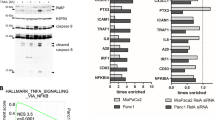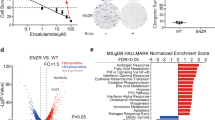Abstract
Tumor necrosis factor (TNF)-related apoptosis-inducing ligand (TRAIL) is a promising candidate for cancer therapy because of its relative tumor selectivity. However, many cancers including pancreatic cancer remain resistant towards TRAIL. To develop TRAIL for cancer therapy of pancreatic carcinoma, it will therefore be pivotal to elucidate the molecular mechanisms of TRAIL resistance. Here, we identify X-linked inhibitor of apoptosis (XIAP) as a regulator of TRAIL sensitivity in pancreatic carcinoma cells. Full activation of effector caspases, loss of mitochondrial membrane potential and cytochrome c release following TRAIL treatment were markedly impaired in pancreatic carcinoma cell lines, which poorly responded to TRAIL (PaTuII, PancTu1, ASPC1, DanG), compared to TRAIL-sensitive Colo357 pancreatic carcinoma cells. Stable downregulation of XIAP by RNA interference significantly reduced survival and enhanced TRAIL-induced apoptosis in pancreatic carcinoma cells. Also, downregulation of XIAP significantly increased CD95-induced cell death. Importantly, knockdown of XIAP strongly inhibited clonogenicity of pancreatic cancer cells treated with TRAIL indicating that XIAP promotes clonogenic survival of pancreatic carcinoma cells. Thus, our findings for the first time indicate that targeting XIAP represents a promising strategy to enhance the antitumor activity of TRAIL in pancreatic cancer, which has important clinical implications.
This is a preview of subscription content, access via your institution
Access options
Subscribe to this journal
Receive 50 print issues and online access
$259.00 per year
only $5.18 per issue
Buy this article
- Purchase on Springer Link
- Instant access to full article PDF
Prices may be subject to local taxes which are calculated during checkout









Similar content being viewed by others
References
Ashkenazi A . (2002). Nat Rev Cancer 2: 420–430.
Amantana A, London CA, Iversen PL, Devi GR . (2004). Mol Cancer Ther 3: 699–707.
Bardeesy N, DePinho RA . (2002). Nat Rev Cancer 2: 897–909.
Bilim V, Kasahara T, Hara N, Takahashi K, Tomita Y . (2003). Int J Cancer 103: 29–37.
Brummelkamp TR, Bernards R, Agami R . (2002). Science 296: 550–553.
Burstein E, Ganesh L, Dick RD, van De Sluis B, Wilkinson JC, Klomp LW et al. (2004). EMBO J 23: 244–254.
Chawla-Sarkar M, Bae SI, Reu FJ, Jacobs BS, Lindner DJ, Borden EC . (2004). Cell Death Differ 11: 915–923.
Cory S, Adams JM . (2002). Nat Rev Cancer 2: 647–656.
Cummins JM, Kohli M, Rago C, Kinzler KW, Vogelstein B, Bunz F . (2004). Cancer Res 64: 3006–3008.
Ehrhardt H, Fulda S, Schmid I, Hiscott J, Debatin KM, Jeremias I . (2003). Oncogene 22: 3842–3852.
Fulda S, Debatin KM . (2004a). Vitam Horm 67: 275–290.
Fulda S, Debatin KM . (2004b). Curr Cancer Drug Targets 4: 569–576.
Fulda S, Meyer E, Debatin KM . (2002a). Oncogene 21: 2283–2294.
Fulda S, Sieverts H, Friesen C, Herr I, Debatin KM . (1997). Cancer Res 57: 3823–3829.
Fulda S, Wick W, Weller M, Debatin KM . (2002b). Nat Med 8: 808–815.
Gerhard MC, Schmid RM, Hacker G . (2002). Br J Cancer 86: 893–898.
Hao Y, Sekine K, Kawabata A, Nakamura H, Ishioka T, Ohata H et al. (2004). Nat Cell Biol 6: 849–860.
Hengartner MO . (2000). Nature 407: 770–776.
Hinz S, Trauzold A, Boenicke L, Sandberg C, Beckmann S, Bayer E et al. (2000). Oncogene 19: 5477–5486.
Hu Y, Cherton-Horvat G, Dragowska V, Baird S, Korneluk RG, Durkin JP et al. (2003). Clin Cancer Res 9: 2826–2836.
Ibrahim SM, Ringel J, Schmidt C, Ringel B, Muller P, Koczan D et al. (2001). Pancreas 23: 72–79.
LeBlanc HN, Ashkenazi A . (2003). Cell Death Differ 10: 66–75.
Lima RT, Martins LM, Guimaraes JE, Sambade C, Vasconcelos MH . (2004). Cancer Gene Ther 11: 309–316.
McManus DC, Lefebvre CA, Cherton-Horvat G, St-Jean M, Kandimalla ER, Agrawal S et al. (2004). Oncogene 23: 8105–8117.
Mohr A, Zwacka RM, Debatin KM, Stahnke K . (2004). Cell Death Differ 11: 1153–1154.
Parker SL, Tong T, Bolden S, Wingo PA . (1997). CA Cancer J Clin 47: 5–27.
Saelens X, Festjens N, Walle LV, van Gurp M, van Loo G, Vandenabeele P . (2004). Oncogene 23: 2861–2874.
Salvesen GS, Duckett CS . (2002). Nat Rev Mol Cell Biol 3: 401–410.
Sasaki H, Sheng Y, Kotsuji F, Tsang BK . (2000). Cancer Res 60: 5659–5666.
Satoh K, Kaneko K, Hirota M, Masamune A, Satoh A, Shimosegawa T . (2001). Pancreas 23: 251–258.
Schneider G, Siveke JT, Eckel F, Schmid RM . (2005). Gastroenterology 128: 1606–1625.
Trauth BC, Klas C, Peters AM, Matzku S, Moller P, Falk W et al. (1989). Science 245: 301–305.
Trauzold A, Schmiedel S, Roder C, Tams C, Christgen M, Oestern S et al. (2003). Br J Cancer 89: 1714–1721.
Trauzold A, Wermann H, Arlt A, Schutze S, Schafer H, Oestern S et al. (2001). Oncogene 20: 4258–4269.
Vischioni B, van der Valk P, Span SW, Kruyt FA, Rodriguez JA, Giaccone G . (2006). Hum Pathol 37: 78–86.
Westphal S, Kalthoff H . (2003). Mol Cancer 2: 6.
Wolff RA, Chiao P, Lenzi R, Pisters PW, Lee JE, Janjan NA et al. (2000). Invest New Drugs 18: 43–56.
Yang L, Cao Z, Yan H, Wood WC . (2003). Cancer Res 63: 6815–6824.
Acknowledgements
We thank Dr Agami (The Netherlands Cancer Institute, Amsterdam, Netherlands) for providing pRETRO-SUPER vector, RM Schmid (Technical University of Munich, Germany) and U Knippschild (University of Ulm, Germany) for providing pancreatic carcinoma cell lines. This work has been partially supported by grants from the Deutsche Forschungsgemeinschaft, the Deutsche Krebshilfe and Else-Kröner-Stiftung (to SF and KMD).
Author information
Authors and Affiliations
Corresponding author
Additional information
Supplementary Information accompanies the paper on the Oncogene website (http://www.nature.com/onc).
Supplementary information
Rights and permissions
About this article
Cite this article
Vogler, M., Dürr, K., Jovanovic, M. et al. Regulation of TRAIL-induced apoptosis by XIAP in pancreatic carcinoma cells. Oncogene 26, 248–257 (2007). https://doi.org/10.1038/sj.onc.1209776
Received:
Revised:
Accepted:
Published:
Issue Date:
DOI: https://doi.org/10.1038/sj.onc.1209776
Keywords
This article is cited by
-
Inhibition of CRM1 activity sensitizes endometrial and ovarian cell lines to TRAIL-induced cell death
Cell Communication and Signaling (2018)
-
An ABCG2 non-substrate anticancer agent FL118 targets drug-resistant cancer stem-like cells and overcomes treatment resistance of human pancreatic cancer
Journal of Experimental & Clinical Cancer Research (2018)
-
Intrinsic and chemo-sensitizing activity of SMAC-mimetics on high-risk childhood acute lymphoblastic leukemia
Cell Death & Disease (2016)
-
NF45 overexpression is associated with poor prognosis and enhanced cell proliferation of pancreatic ductal adenocarcinoma
Molecular and Cellular Biochemistry (2015)
-
Identification of IRF1 as critical dual regulator of Smac mimetic-induced apoptosis and inflammatory cytokine response
Cell Death & Disease (2014)



